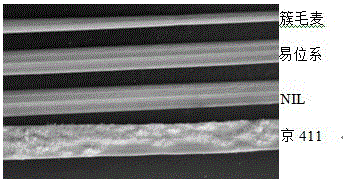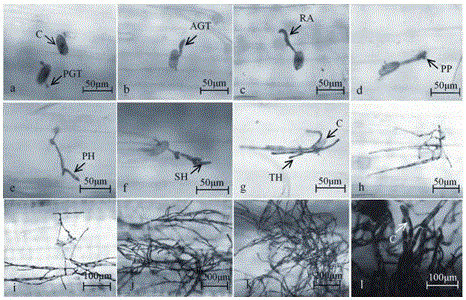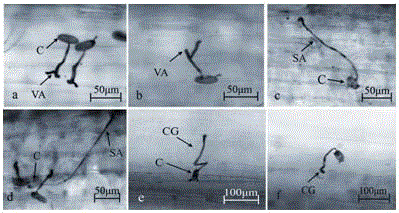The Sequence and Application of Introgression of 6vs DNA in Wheat Powdery Mildew Resistant Near-isogenic Lines
A near-isogenic, powdery mildew-resistant technology, applied in the field of agricultural biotechnology engineering, can solve the problems of tracking, i.e., donor gene detection, which is less reported, susceptible to development, environmental conditions and human factors, and long cultivation time.
- Summary
- Abstract
- Description
- Claims
- Application Information
AI Technical Summary
Problems solved by technology
Method used
Image
Examples
Embodiment 1
[0068] Preparation of near-isogenic lines and identification of disease resistance:
[0069] The preparation of the near-isogenic line of the present invention: the common cultivated wheat Jing 411 (Triticum aestivum, 2N=6X=42, AABBDD) as the test material has excellent agronomic properties, but is susceptible to powdery mildew; The translocation line 6VS.6AL (T6VS.6AL), the 6VS in the translocation line comes from Haynaldiavillosa (2N=2X=14, VV). The near-isogenic line Jing 411 / 6VS.6AL / Jing 411 prepared with 6VS.6AL as the disease-resistant donor parent and Jing 411 as the recurrent parent 7 (Near-isogenic Lines, NIL). The process is T6VS.6AL×Jing 411 hybridization, resulting in F 1 All are resistant to powdery mildew. Jing 411 was used for 7 generations of backcrossing, and 1 generation of self-crossing bred the near-isogenic line 411 / 6VS.6AL / Jing 411 resistant to powdery mildew. 7 ; For every hybridization and backcrossing, disease-resistant single plants were selected u...
Embodiment 2
[0071] Detection of AFLP Derived from 6VS Powdery Mildew Resistance Gene in NIL
[0072]Wheat DNA was extracted using the CTAB method with a slight modification: Weigh 0.2g of young leaves and cut them into pieces in a mortar, add liquid nitrogen and quickly grind them into powder, transfer them to a 5ml centrifuge tube, add 1ml of DNA extraction buffer (0.1M Tris· Cl, pH8.0; 0.02mM EDTA, pH8.0; 1.4M NaCl; 4%CTAB; 1%PVP), in a water bath at 65°C for 90min, shaking once every 10min during this period; at 10000rpm, centrifuge at 4°C for 10min, and take the supernatant in To a new 5ml centrifuge tube, add an equal volume of phenol-chloroform-isoamyl alcohol (25 ׃24׃1) and gently invert up and down to mix well, centrifuge at 10000rpm for 10min, draw the supernatant into a new 5ml centrifuge tube, and add again Extract by volume phenol-chloroform-isoamyl alcohol, centrifuge at 10,000rpm for 10min, absorb the upper aqueous phase into a 2ml centrifuge tube; add an equal volume of col...
Embodiment 3
[0075] Molecular evidence obtained from 6VS in NIL
[0076] Using the AFLP method, molecular marker screening was carried out in Trichosanthes villosa (VV), translocation lines T6VS.6AL, NIL, and the recurrent parent common wheat Jing 411. In this experiment, 15 screened AFLP profiles were listed ( Figure 5 ), among which type Ⅰ is an AFLP pattern that exists in T. villosa, T6VS.6AL, NIL and recurrent parents, and the frequency of this AFLP pattern is 3.8%. Trichophyllum is a close wild species of common wheat, which proves that they have certain homology in type I AFLP genome, but there is no correlation with powdery mildew resistance; , NIL and AFLP patterns in common wheat species, since T6VS.6AL and NIL all have 6VS chromosomes from T. Wheat genome; type III: present only in T. villosa, absent in T6VS.6AL, NIL, and common wheat. Since T6VS.6AL and NIL do not exist in the translocation line T6VS.6AL and NIL with T. villosa 6VS, this type of AFLP Bands are also not associ...
PUM
 Login to View More
Login to View More Abstract
Description
Claims
Application Information
 Login to View More
Login to View More - R&D Engineer
- R&D Manager
- IP Professional
- Industry Leading Data Capabilities
- Powerful AI technology
- Patent DNA Extraction
Browse by: Latest US Patents, China's latest patents, Technical Efficacy Thesaurus, Application Domain, Technology Topic, Popular Technical Reports.
© 2024 PatSnap. All rights reserved.Legal|Privacy policy|Modern Slavery Act Transparency Statement|Sitemap|About US| Contact US: help@patsnap.com










